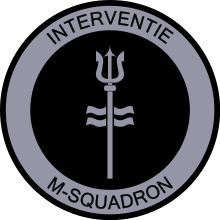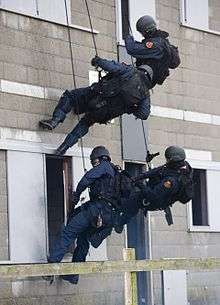M-Squadron
M-Squadron, formerly the Unit Interventie Mariniers (Marine Intervention Unit, UIM), and before that known as the Bijzondere Bijstands Eenheid (Special Support Unit, BBE),[2] is an elite Dutch special forces unit, which is specially trained for intervention missions. It is part of NLMARSOF of the Netherlands Marine Corps.
| M-Squadron | |
|---|---|
 | |
| Active | February 22, 1973 – Present |
| Country | |
| Branch | Dutch Marine Corps |
| Type | Maritime Special Forces |
| Role | Special operations Counter-terrorism Law Enforcement |
| Size | Classified |
| Part of | NLMARSOF |
| Garrison/HQ | Mariniers Training Commando, Doorn |
| Motto(s) | Semper Paratus Pro Justitia[1] ("Always Ready for Justice") |
| Commanders | |
| Current commander | Classified |
The unit is known to have a policy where hostiles are to be captured alive as a priority through non-violent methods even though they are allowed to use deadly force.[2]
History
On 22 February 1973, the Dutch government officially created a specialist counter-terrorism unit in response to the Munich massacre, when 11 Israeli athletes were murdered by Palestine pro-Fatah militants.[3] The government felt the urge of protecting the nation against such incidents in the future, and so members of the Dutch Marine Corps were selected for this special unit. Marines were chosen because, at that time, they were particularly notorious: Dutch marines are hardened, highly trained, professional soldiers.
On July 1, 2006, a new government organ, Dienst Speciale Interventies (DSI) was founded.[4] This is a joint operations centre for counter-terrorism actions in the Netherlands. Members of the UIM and special police units work together, and form a Unit Interventie, which is a joint task force of Defence and police personnel.
As part of the reorganization, the BBE changed its name in 2006 to the UIM.[3] In 2009, the UIM changed its name once again to M-Squadron.[3]

The unit was reorganized into the Maritime Special Operations Force since January 1, 2009.[5]
Role
It consists of a selection of specially trained marines of the Dutch Marine Corps, and it is part of the Netherlands Maritime Special Operations Forces (NLMARSOF), which is the maritime counterpart of the Dutch Army's Korps Commandotroepen. NLMARSOF is able to operate in and outside of the Netherlands, with emphasis on maritime special operations.
It currently consists of three SF units;[5][3]
- C Squadron (Mountain Leader Recon and Amphibian Recon) – Foreign Operations
- M Squadron (Counter-Terrorism) – Domestic Operations
- T Squadron (Training Squadron)
- Special Operation Forces Support Group
M-Squadron consists of teams of six operators, each team and each operator with their own specialty. Among those are diver and breach teams. Tasks are:
- To conduct special operations on sea and land;
- To conduct quick-reaction counter-terrorism and hostage release operations in the Netherlands;
- To provide quick-reaction maritime intervention (harbours, oil platforms, ships, etc.);
- To assist the Dutch police and Royal Marechaussee in domestic joint law enforcement and counter-terrorism operations;
- To act as a security detachment on board Royal Netherlands Navy ships during humanitarian or peace-enforcing/-keeping missions;
Within DSI
The Dienst Speciale Interventies is the joint operations centre for domestic CT operations, and it combines special units from the Ministries of Defence and Justice. These units are:
- Unit Interventie Mariniers (UIM – the crack CT unit of the Netherlands Marine Corps);
- Brigade Speciale Beveiligingsopdrachten (BSB – special security unit of the Royal Marechaussee)
- Arrestatieteam (AT – the SWAT-team of the Dutch police)
- Unit Interventie (UI – Elite CT unit of the National Police)
Operations
The UIM has seen a lot of action since its creation. The first real intervention mission was the recapture of the Scheveningen prison in October 1974.[6] Operators used hand-to-hand combat and stun grenades against jailed terrorists, who had revolted and held the prison under siege.[6]
The best-known intervention mission was ending the combined siege of a train and a primary school, which was done by South Moluccan terrorists.[6] The UIM managed to kill the six captors on the train during a short but precise raid. Two hostages did not survive this. The raid was successful due to the fact that the Royal Netherlands Air Force was called in, with six F-104 Starfighter aircraft making very low flypast manoeuvres in full afterburn.[6] This was mainly a distraction, allowing for a swift raid and the killing of the six captors on board.[6] The siege at the primary school ended not long after the train siege had ended.
On 13 March 1978, the UIM responded to a province hall hostage crisis in Assen. The raid came just in time: the hijackers had almost executed two people.
The UIM was meant to be deployed to enforce arms embargoes in the Balkans, but they were never deployed in the 1990s.[2]
A known operation of the UIM was on 10 November 2004 in The Hague. The police had tried to arrest Ismail A. and Jason W. (members of the Hofstad Network) in a house at the Laakkwartier, but failed, as three police officers had been injured by grenades thrown at them by the terrorists. UIM operators were ordered to secure and maintain the site. After a successful raid, the two young terrorists were arrested.
In 2008, the UIM had been active in the seas near Somalia as a security detachment for the Royal Netherlands Navy frigate Hr. Ms. De Ruyter, that was tasked with the escort of cargo ships that were contracted by the United Nations' World Food Programme. The unit was deployed several times to fight off pirates that attempted to raid the ships, and some teams were stationed on some of the ships as well.
In April 2010, an UIM-team embarked on board Hr. Ms. Tromp re-captured the German container ship MS Taipan off the coast of Somalia, that was under the control of Somali pirates. Though multiple shots were fired, including a machine gun barrage on the ship's bridge, the only injury was an operator that was slightly injured when he fell while storming the ship. A video released by the Royal Netherlands Navy, shows helmet camera footage of the Marines storming and re-taking the ship.[7]
Equipment
Weapons
- Accuracy International AWSM-F sniper rifle
- Heckler & Koch MP7
- FN P90 submachine gun[8][9][10]
- Glock 17 pistol with Surefire taclight[11]
- Heckler & Koch HK416 carbine, being used to replace the C8s.[12]
- Heckler & Koch MP5 submachine gun
- Heckler & Koch MSG-90 sniper rifle
- Sig Sauer P226 pistol[12]
- Steyr SSG sniper rifle
Former Weapons
- Colt Canada C8NLD carbine, being phased out of service.[13]
Transport Support
The Royal Netherlands Navy helicopters provide airlift, and additional support.
Three Dienst Luchtvaart Politie (Police Aviation Service) AW139 medium-sized helicopters are also available for use by the Dienst Speciale Interventies.
References
- https://www.maritiemdigitaal.nl/index.cfm?event=search.getdetail&id=107035978
- Miller 2003, p. 76.
- https://core.ac.uk/download/pdf/36700937.pdf
- https://www.zhzactueel.nl/2019/10/12/dienst-speciale-interventies-doet-inval-bij-ernstig-verwarde-man-in-gorinchem/
- https://www.dutchdefencepress.com/unit-interventie-mariniers/
- https://web.archive.org/web/20080515133216/http://www.specwarnet.net/europe/bbe.htm
- Video of the Taipan raid (Dutch spoken, English subtitles)
- Katz, Samuel M. (November 1, 2004). Special Operations Report: "Close Combat Commandos – Inside the Royal Netherlands BBE Counterterrorist Unit". Special Operations Report by GSE Inc (ISBN 978-0974325378), Volume 2.
- Janssen Lok, Joris (July 24, 2007). "Special Forces Spending Fest". Aviation Week, Ares – A Defense Technology Blog. Retrieved 2009-09-01.
- “Kordaat Optreden Nederlanders Verrast Taliban” (in Dutch). De Telegraaf, 11/6/2006.
- Neville 2017, p. 22.
- https://www.dutchdefencepress.com/elite-operators-of-the-royal-netherlands-marine-corps/
- Unit Interventie Mariniers by Marcin "Mirra" Dudojc, OpForce magazine, page 11.
Bibliography
- Neville, Leigh (2017). European Counter-Terrorist Units 1972–2017. Oxford: Osprey Publishing. ISBN 978-1472825278.
- Miller, David, ed. (2003). Illustrated Directory of Special Forces. St. Paul, Minnesota: Salamander Books. ISBN 978-0760314197.
| Wikimedia Commons has media related to Unit Interventie Mariniers. |